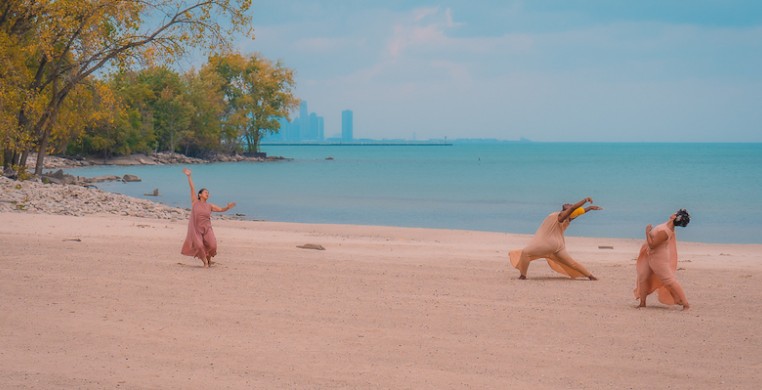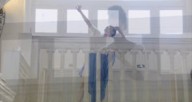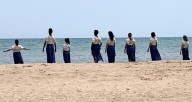“Rooting” and “ephemeral” seem counterintuitive on paper, but these concepts are beautifully and harmoniously embodied in Ayako Kato/Art Union Humanscape’s “Inception: ETHOS Episode II.” The durational nature-walk style dance and music installation premiered on Indigenous Peoples’ Day and marked the second iteration of Kato’s ETHOS trilogy. The outdoor performance grounded itself in humanity’s ancient and ancestral relationships to nature as well as our present connections to land—expanding the trilogy’s mighty physical inquiry into an ideal ethos of humanity and evolving practice of making such an intangible matter felt and seen.
“Inception: ETHOS Episode II” unfolded across the 65-acre South Shore Cultural Center Park, rotating small audience groups into and out of guided experiences stationed throughout the expansive landscape. Each encounter had its own evanescent life cycle that responded, with sensitivity, to shifting winds, swaying grass, soft trembling leaves on trees, granular sand, boundless skies, modest waves, swooping birds, an all-embracing sun and more. The process of continuously leaving poets—Kato’s chosen identification for the collaborating artists of ETHOS—behind to venture towards other performers coaxed me into an appreciation for the beauty of being in the moment and in relation to nature.
My journey began with a gift from the poets—a small bell attached to a soft, braided loop of twine. I slipped this over my wrist and smiled as I heard the light chiming of my offering join an un-orchestrated chorus of bells swaying below other audience members’ wrists. The instruments’ varied pitches continued to gently collide as our guide, Angela Gronroos, walked us to meet dancers Lesley Keller-Reed and Aaliyah Christina and musician Mabel Kwan for an “ETHOS Movement Land Acknowledgment.” Christina stepped into the center of the circle formation in which we all stood and asked us to mirror her slow-paced movements while she shared the Land Acknowledgment aloud. Our attempted unison—notably a recurring gesture of one hand to heart, one hand to sky—added a layer of shared physicality and responsibility to the collective listening we were already practicing sonically with our bells.
After a guided meditation with Amanda Maraist, we moved to the beach for “Shore Evolution Dance” with Tuli Bera, Darling Squire and Kato. As we approached them, I kept Maraist’s prompting in mind: “Exhale to expand.” The trio stood stoically with their backs to us; their long, airy dresses billowed in the East-blowing winds, beckoning them towards the calm waters ahead. They continued forward at a pace that seemed to stretch time. Without turning their heads to look at one another, Bera, Squire and Kato simultaneously began rotating their palms to the shoreline, sending a soft ripple through their spines, opening up their chests and tilting their focus slightly higher to meet the sun’s warmth. The upward momentum continued as each poet unhurriedly extended their arms out from their sides in a generous arc overhead—all the while, stepping closer to the lake.
The sustained connection between the trio and their shared trajectory forward suspended my inhales. The further away they journeyed from us, the more tightness I felt in my chest. Their persistent strides ahead continued to widen the distance between their backs and our fronts; broadening the gap between their pasts and our futures, and opening up the possibilities of what could manifest in the space between.
Bera and Kato reached the shoreline, blurring what, at a distance, looked like a linear and definite division between land and lake. Squire continued past them into the water, absorbing the change of environment with an unwavering tranquility. I noticed my chest soften as I let out a restorative exhale.
Reluctant to leave, I watched over my shoulder as the poets gradually turned to face a new group of viewers, reversing the directionality of their elastic pathway. They met a new set of onlookers in a mutual confrontation of a shared present. The trio slowly descented from their feet to all-fours, then to their stomachs, crawling with a deliberate and expressively visceral urgency. Eventually, they found a resting state on their backs with their limbs raised to the weighted clouds above.
Christina returned for her offering, “Prayer,” taking place in a section of the park Kato calls “The Path to the Past.” Her intentional movements, supported by poignant moments of relative stillness, exuded care and reached beyond the horizon, which she often traced with her fingertips. On the walk to “Peninsula: Dance with Ancestors,” Gronroos prompted us to think of someone from our past: “a family member, someone who has meant a lot to us, or an ancestor in our own lineage—and keep them in mind as we witness.” With my Oma in memory, I watched Danielle Ross (re)trace what felt like sacred footholds as she inched backwards—away from the grassy precipice and towards the firm stone bench where we sat. She kept her arms elongated out from her sides in a stabilizing opposition, measuring the shifting winds on her journey backwards. I felt an intimate proximity, profoundly dissimilar yet inexpressibly the same as the palpable distance I experienced in the Shore Evolution Dance. Ross cautiously turned to sit shoulder-to-shoulder with us. In this moment, I wondered if Oma could see the lake too.
Bera and Squire returned to guide us on the “Path to Present.” Patches of residual sand in Bera’s hair reminded me again of her journey from shore to land. Both Bera and Squire struck a bell against their sternums, letting echoes of their heartbeats reverberate into the airwaves around us as they parted ways. I chose to follow Squire off the walking trail to a new environment where soil and tree roots merged with uneven slabs of concrete on which musician Michael Zerang stood. Squire and Zerang were in direct conversation with one another, overlaying a multitude of physical and sonic textures to an already converging soundscape. These poets cultivated a mesmerizing tension between themselves and our surroundings that was difficult to part ways with…
The exquisitely fluid ebb and flow of the dancers’ relationship to one another spatially and kinesthetically in the concluding “Circle Dance by Poets & Sway Dance” weaved the experience so cohesively that I lost my sense of time completely. The atmosphere seemed to inflate and deflate above an expanding and contracting soil below. Is this what Mother Earth’s breath looks like? Is this what it feels like?
Under Kato’s direction, “Inception: ETHOS Episode II” offered a timely (and timeless) meditation on evolving practices of environmental stewardship that are crucial for our collective survival. The poets of “Inception” thoughtfully drew together a sensibility from furyu (wind flow)—the traditional Japanese aesthetic within which Kato is known to work—and a relationality central to Traditional Ecological Knowledge. A compelling combination that simultaneously embraces both the molecular and the cosmic; “ETHOS” is a feat made possible through an abundance of integrity evident in Kato’s work that embodies a gentle power and divine beauty paralleled only by nature itself.



